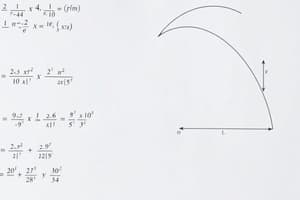Podcast
Questions and Answers
What is the equation of the function $f(x) = x^2 - 3x + 1$ reflected in the y-axis?
What is the equation of the function $f(x) = x^2 - 3x + 1$ reflected in the y-axis?
- $f(x) = -x^2 + 3x - 1$
- $f(x) = x^2 - 3x + 1$
- $f(x) = x^4 + 3x + 1$
- $f(x) = -x^2 - 3x + 1$ (correct)
A horizontal translation involves moving a graph left or right on the coordinate plane.
A horizontal translation involves moving a graph left or right on the coordinate plane.
True (A)
What is the effect of a vertical dilation by a factor of 3 on the function $y = f(x)$?
What is the effect of a vertical dilation by a factor of 3 on the function $y = f(x)$?
y = 3f(x)
The function $y = f(2x)$ represents a ______ dilation of the graph $y = f(x)$.
The function $y = f(2x)$ represents a ______ dilation of the graph $y = f(x)$.
Match the transformations with their descriptions:
Match the transformations with their descriptions:
What happens to the graph of a function when 𝑐 > 0?
What happens to the graph of a function when 𝑐 > 0?
If 𝑎 < 1, the graph of a function is stretched horizontally.
If 𝑎 < 1, the graph of a function is stretched horizontally.
What effect does a vertical dilation with scale factor 𝑘 have when $0 < k < 1$?
What effect does a vertical dilation with scale factor 𝑘 have when $0 < k < 1$?
If 𝑏 > 0, the graph shifts to the __________.
If 𝑏 > 0, the graph shifts to the __________.
Which transformation occurs first when transforming a graph?
Which transformation occurs first when transforming a graph?
A scale factor 𝑘 = −1 will result in a horizontal reflection of the graph.
A scale factor 𝑘 = −1 will result in a horizontal reflection of the graph.
Where does the graph of $y = log(x)$ move if it is translated down by 4 units?
Where does the graph of $y = log(x)$ move if it is translated down by 4 units?
Match the type of transformation with its description:
Match the type of transformation with its description:
What type of transformation does the equation $y = f(x) + c$ represent?
What type of transformation does the equation $y = f(x) + c$ represent?
A horizontal translation involves moving the graph either up or down.
A horizontal translation involves moving the graph either up or down.
What happens to the graph of a function when it is dilated by a factor of $k$?
What happens to the graph of a function when it is dilated by a factor of $k$?
The graph of $y = f(ax)$ undergoes a __________ dilation depending on the value of 'a'.
The graph of $y = f(ax)$ undergoes a __________ dilation depending on the value of 'a'.
Match the following transformations with their descriptions:
Match the following transformations with their descriptions:
Which of the following equations represents a reflection of the graph over the x-axis?
Which of the following equations represents a reflection of the graph over the x-axis?
In the transformation sequence, the order of applying horizontal and vertical translations does not matter.
In the transformation sequence, the order of applying horizontal and vertical translations does not matter.
When applying a vertical translation of 5 units, what is the general form of the transformed equation?
When applying a vertical translation of 5 units, what is the general form of the transformed equation?
Flashcards
Function Transformations
Function Transformations
Changes made to a function, including dilations (stretching or shrinking) and translations (shifts).
Dilation
Dilation
A transformation that changes the size of a function's graph.
Translation
Translation
A transformation that shifts a function's graph.
Equation of transformed function
Equation of transformed function
Signup and view all the flashcards
Combination of Transformations
Combination of Transformations
Signup and view all the flashcards
Vertical Translation
Vertical Translation
Signup and view all the flashcards
Horizontal Translation
Horizontal Translation
Signup and view all the flashcards
Vertical Dilation
Vertical Dilation
Signup and view all the flashcards
Horizontal Dilation
Horizontal Dilation
Signup and view all the flashcards
Reflection in the x-axis
Reflection in the x-axis
Signup and view all the flashcards
Reflection in the y-axis
Reflection in the y-axis
Signup and view all the flashcards
Order of Transformations
Order of Transformations
Signup and view all the flashcards
Transformations on Stationary Points
Transformations on Stationary Points
Signup and view all the flashcards
Transformation Notation
Transformation Notation
Signup and view all the flashcards
Order Matters
Order Matters
Signup and view all the flashcards
Function (n.)
Function (n.)
Signup and view all the flashcards
𝑦 = 𝑓(𝑥) + 𝑐
𝑦 = 𝑓(𝑥) + 𝑐
Signup and view all the flashcards
Study Notes
HSC Mathematics Advanced - Functions
- Topic: Functions
- Presented by Emma Crosswell
- Year: 2019
MA-F2: Graphing Techniques
- Topic: Graphing Techniques for Functions
- Presented by Emma Crosswell
- Year: 2019
- Slides are for HSC Mathematics Advanced course
- Slides/presentation are about transformations of functions
Transformations of Functions
- Syllabus dot points:
- Apply transformations to functions of the form y = kf(a(x + b)) + c, where f(x) is a polynomial, reciprocal, absolute value, exponential or logarithmic function and a, b, c and k are constants.
- Examine translations and graphs of y = f(x) + c and y = f(x + b) using technology.
- Examine dilations and graphs of y = kf(x) and y = f(ax) using technology.
- Recognize the order of transformations is important in constructing the resulting function or graph.
- Key transformations covered
- Vertical and horizontal translations
- Vertical and horizontal dilations
- Combination of transformations
- Reflection
- Rotation
- Translation
- Dilation
What's in this lesson?
- Vertical and horizontal translations
- Vertical and horizontal dilations
- Combination of transformations
- Reflection
- Rotation
- Translation
- Dilation
Worked Examples
- Multiple Worked Examples of various types of transformations of functions illustrated visually
- Example of how y = x² – 5 and y = (x – 5)² relate to the graph of y = x²
- Example of finding the image point of a point on a function after a translation
- Example of sketching graphs of y = |x| – 4 and y = |x + 4|
Multiple Choice Activities and Responses
- Multiple choice questions related to different transformations of the given functions.
- Questions about the equations of transformed functions
- Questions about image points of a given function
- Finding the equations of graphs that are reflected and dilated.
- Finding equations of the transformed functions (e.g. vertical translation of 3 units, horizontal translation of 6 to the left, horizontal dilation with scale factor 1/2).
- Questions about transformations given a stationary point on a parent function.
- Sketching graphs
- Explaining how graphs are related
Combination of Transformations
- Function can have multiple different transformations
- The transformation can be represented with functions of the form y = kf(a(x + b)) + c, where c, a, b and k are constants
- The transformations are defined by vertical and horizontal translations and dilations.
Additional Information (Last slide, important for understanding)
- The order of transformations is important.
- Dilations come before translations
Copyright and Disclaimer
- Copyright for portions of the materials belongs to NSW Education Standards Authority.
- NSW Education Standards Authority does not endorse or guarantee the correctness/accuracy of material.
- Liability is excluded for any damage or loss regarding use of material.
Studying That Suits You
Use AI to generate personalized quizzes and flashcards to suit your learning preferences.




